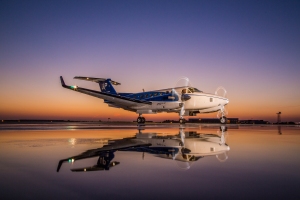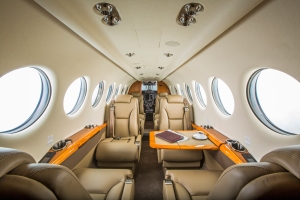For me, the biggest news out of last week’s National Business Aircraft Association was the upcoming first anniversary on November 1 of Wheels Up, a private aviation company that has single handedly re-invented regional air services. Its most important contribution to the industry, however, is the fact that it has expanded the market for private aviation services by bringing down the entry fee.

Mind you, New York City-based Wheels Up is not an airline. But it does deliver air service to hundreds of communities. Airline consolidation, coupled with the recession, eliminated approximately 15 percent of airline capacity, leaving many communities off the scheduled airline map. For these communities, the old admonition “you can’t get there from here” has taken on a new, ominous meaning.
Wheels Up CEO Kenny Dichter is careful to explain that Wheels Up is not even an aviation company. “We are a technology company,” he said at NBAA, “that is trying to substantially change the market.”
President David Baxt agrees. “Private aviation has been a matter of poaching each other’s customers,” he told me. “We are expanding the market, democratizing private aviation, and driving new people to it.”
Wheels Up calls its services revolutionary and I agree. I have been watching the steady decline of the nation’s regional airlines and community air service. Decline, you say? They are 50 percent of all departures. How can they be in decline? They are in decline because they are no longer the masters of their own fate. They have been steadily pressured by their mainline partners and have gone from a respectable eight- to 10-percent return on investment to struggling to find a new model that works under the more restrictive mainline regimes.
A recent conversation with SkyWest CEO Jerry Atkin was illuminating. When asked about the development of a point-to-point scheduled service, he was unenthusiastic. “But,” he said, tellingly, “I am so focused on hub and spoke, I really don’t know.”
After all, it has been tried before. First there was the late Independence Air and then, ExpressJet, which gained respectable traction with its point-to-point service. Express Jet, however, launched its branded service just as fuel prices were rising. It ultimately fell to $145 per-barrel fuel. Still, its success before the fuel increase left me wondering if there were a place for such entrepreneurial creativity with lower fuel prices. Could one be successful returning to the basics – connecting communities of interest? Could one bring back the out-and-back-in-one-day business trip that built the regional airlines?
I know barriers to entry services are high. Regional jets were not designed for fuel that is more than $50 to $60 per barrel. No aircraft is. The age of the current turboprops in regional airline service constitutes another barrier. Such airlines as Kenmore Air, Great Lakes and Cape Air have been forced to develop their own manufacturing operations to keep their Beech 1900s, Cessna 402s, and Twin Otters in operation. There are no new commuter-style turboprops in the offing. Many of the routes using Saab 340s, Embraer Brasilias and ATR 42s had long since dropped off the commercial grid and these aircraft, too, are now old.
New pilot rules – 1,500 hours before being considered for the right seat – created a pilot shortage at regionals so acute that such successful companies as Republic Airways Holdings grounded dozens of aircraft and Great Lakes reduced the 19-seat count of a Beech 1900 to nine to accommodate the different rules that would allow them to hire pilots.
Still, I have faith point-to-point services could be successful, given the growing dissatisfaction with airline service and the fact many lost points were once the bread and butter of the regional industry. Since the dawn of commercial aviation, communities have always changed out airlines as larger airlines dropped service; first, in favor of the local service carriers and, post-deregulation, to regional airlines which were flying Pipers and Beechcraft.
Regional services have taken their turn at abandonment at a time when so much is stacked against the advent of replacement carriers. The big question, however, is whether passengers have been so trained to drive to distant low-fare airports, that they have broken the historical chain. Still, factories and businesses are located off the commercial grid and the price of time is getting dearer as commercial service gets more complex.
Just as I have been observing regional airline changes, I have also been watching the business aviation market and have been puzzled by the lack of efforts to expand the market. Wheels Up has done its part but there is so much more that can be done if the industry would only do it.
There are no fewer than a dozen studies that make the business case for business aviation that will attract more and more passengers to business aviation, yet they are not being used. A glimpse can be seen in just two studies. The growing hassle factor with commercial aviation cost the airlines $38 million in avoided trips and the U.S. economy $85 billion and 900,000 jobs in 2013. Another study indicated that at the top of the last business cycle, when congestion was at its worst, business aviation use rose from 16 percent of all premium business trips to 41%.
We seem to be reaching a perfect storm in business aviation. Consider this: Given the hassle factors, airlines are trying to keep the business/first class passenger with new perks such as gate-to-gate transfers by luxury car, early boarding and posh service once on board. Delta and Lufthansa are both offering business jet services to its elite passengers to get them to the hub. Still, these elites have to run the airport gauntlet. Long walks from the parking lot, security, crowded terminals, trying to weave their way through the gate lice to get to the early boarding and enduring regional jets once they get there. All this reduces the gap between business and commercial aviation.
As I was covering the Wheels Up press conferences, I realized it had invented the next iteration of regional air service one that had little to do with scheduled service but everything to do with turning travel costs into an investment in time. It has created a new business model at a time when business and private aviation can become a viable alternative to commercial aviation if it is smart.

Key to this strategy is the acquisition of 105 Beech King Air 350i’s that Baxt termed a little more “politically correct,” perhaps, than the popular misconception of the business jet. It has the economics to fly the mission just as efficiently as, but less expensively, than a business jet. Wheels Up’s operating partner, Gama Aviation, has no problem attracting pilots, having built its pilot corps to 150 in the past year with a 2,500-hour minimum. Gama Aviation CEO Marwan Khalek said at NBAA that introducing 37 aircraft inside a year was akin to starting a commuter airline. He was, in fact, reading my mind.
Launched in August 2013 to disrupt private aviation, Wheels Up took its first flight on November 1. It introduced a membership-based program that makes private aviation far more accessible by reducing the investment needed upfront. Its fleet has expanded from zero to 37 aircraft (27 King Airs and, since June, 10 Citation Excel/XLSs) owing to the unique partnership it forged with Gama, which dry leases, manages, provides line maintenance and is the sole operator of the aircraft. Wheels up handles the sales, marketing, customer service, reservations and concierge services that drive membership. The aircraft are staged at regional hubs across the U.S.
The cost for an individual is $15,750 and $25,000 for a corporate membership, small considering the price of a single business and first class fare. Previously, one would need $50,000 to $100,000 to participate in the private aviation pyramid. Cost per hour for the King Air turboprop is $3,950, which, said the company, on a per-seat basis, could be a very affordable $500 per hour. The Citation Excel goes for $6,950 per hour.
A year later, the company has 750 members and by year’s end expects to surpass the 1,000 mark. It currently schedules 40 flights daily for members and expects that to rise to 50 to 70 flights daily by year’s end.
“The world is a different place compared to when Marquis Jet was founded in 2001,” said Dichter, who led Marquis Jet to cumulative revenues in excess of $4 billion, and another $1 billion in fractional sales, during his tenure. “Customers want the advantages of private aviation but demand the utmost cost benefit, flexibility, simplicity and safety standards. With Wheels Up, we deliver just that.”
Clearly it has struck a chord and it is no surprise. Passengers are ripe for considering other options if business aviation would only market itself properly. Wheels Up may not be the answer to returning scheduled air service to communities but it does do one thing. It gets you from here to there.



